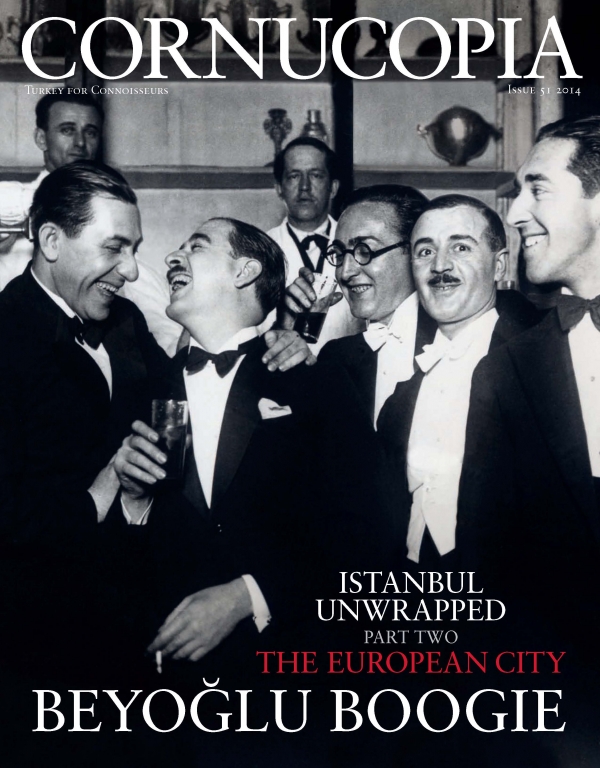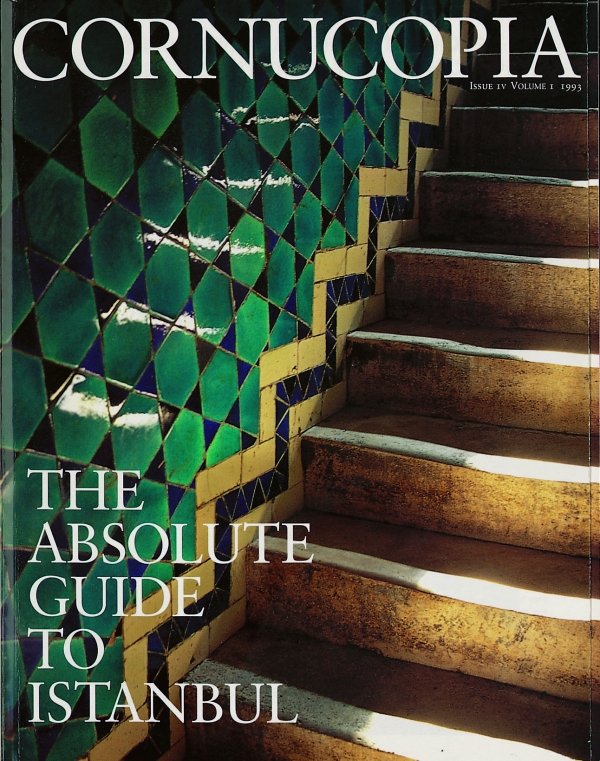Buy or gift a stand-alone digital subscription and get unlimited access to dozens of back issues for just £18.99 / $18.99 a year.
Please register at www.exacteditions.com/digital/cornucopia with your subscriber account number or contact subscriptions@cornucopia.net
Buy a digital subscription Go to the Digital EditionShopping has superficial connotations, associated with designer labels, doorstop-sized airport fiction and men palming off their women with an outing on the platinum card. To make that assumption about shopping in Istanbul, though, is to make a grave mistake. To set off into this city on a shopping expedition is to explore its culture in the most profound and fruitful way.
That the city exists at all is because of its position as a trading centre, with its perfect natural harbour. It is the crossing point for the Bosphorus, gives access to the Black Sea, and is a launch-pad for crossing the Sea of Marmara or navigating the Eastern Mediterranean. What you encounter today connects to the past in a way that can be read easily as you walk through the oldest parts of the city: an ancient han built for secure trade and storage, currently housing a cluster of silver dealers; or workshops that are still operating – perhaps not exactly for the purpose they were built for, but in similar fashion. Even the gleaming malls stuffed with designer labels offer a shopping experience with a linear descent from the original Grand Bazaar.
Meanwhile, most parts of modern Istanbul have some kind of weekly outdoor market selling the local produce as well as practical items such as underwear or kitchen utensils. These markets put a British or American “farmers’ market” to shame, such is the freshness, colour and gutsy vigour of the produce. Even a posh residential area such as Etiler, close to the British School, has its market (on Monday), where strong youths are on hand to act as porters – with huge baskets that they carry like rucksacks – in case you get carried away. Kuzguncuk has a proper farmers’ market on Sunday, where real country producers offer home-made bread and cheeses, free-range eggs, wild mushrooms and interesting herbs and salads.
Perhaps most valuable is the contact that can take place with each purchase. There are other cities where this applies, but it applies particularly to Istanbul. If you can communicate with the trader – language can be a problem, but in practice rarely is – and are prepared to spend the time, your encounters can give you a profound insight into the city past and present. If asked, people are generous with information – about themselves, the history of their craft, the story of their goods. This is especially true if you are looking for an old carpet, antiques, or modern examples of traditional crafts such as metalwork or pottery. Thus a simple shopping expedition – a little light relief after mosques, palaces, museums – can turn into an effortless course in social, political and economic history.
Now, what will you be shopping for? If you live in Istanbul, you have the bonus of not being in such a hurry. You will already know that the best way of finding anything is by word of mouth and that, despite the efforts of modern technology, there is no substitute for a face-to-face encounter. You will understand the need to go and see for yourself, often more than once, to find what you are looking for.
If you are visiting, you might need help to know what to buy and where to find it. You may want to return home with something in particular: on my last visit, in early summer, my children demanded that I take back apricots and cherries, which have never tasted as good as when we lived in Istanbul. This I managed in Beyoğlu’s Fish Market (Balık Pazarı) and by using two layers of plastic bags in my hand luggage. Bringing home their favourite Mado ice cream proved, naturally, to be impossible – better just to eat it on the spot (there are branches all over the city). Pistachios and lokum were easy, as was Turkish delight, bought from Hacı Bekir on Istiklâl Caddesi. Although its shopfront has recently been unsympathetically municipalised, the interior is unspoiled, and the slabs of helva, trays of chocolates and vast jars of multicoloured sweets topped by conical brass lids are still beautifully old-fashioned. I did not quite manage a trip to Bebek to buy the legendary badem ezmesi, marzipan made simply from the best almonds and sugar.
The great Grand Bazaar, or literally Covered Bazaar (Kapalı Çarşı), and its environs can yield anything from touristy tat to wonderful, high-quality anything: gold, silver, ceramics, textiles and household goods. It is a complete world, almost the whole of life itself for its shopkeepers, some of whom are fourth- or fifth-generation and are very much worth getting to know. It’s here that you get a sense of life and work being one and the same, as people eat, work and pray under one roof. For some in this masculine universe, friends and social life are also concentrated convivially within the Bazaar.
Together with Thursday’s outdoor bazaar on the other side of Istanbul, in Ulus (in the shadow of the Akmerkez shopping centre), the wider Bazaar area is also a place to find seconds from Turkish factories: Ralph Lauren polo shirts, designer rip-offs of not quite the latest Puma trainers and Vuitton luggage (not recommended, for copyright reasons, but nonetheless desirable, especially as presents for teenagers with a fashion profile to maintain). The interior of the Bazaar is dominated by sellers of higher-value items, including some of the greatest antique and carpet dealers in the city, yet most wants can be satisfied around it, and vast numbers of ordinary people do their routine shopping there.
As a visitor, it’s easy and pleasurable to dovetail your shopping with sightseeing: the lovely Arasta Bazaar, built to finance the great mosque of Sultanahmet, houses some of the finest textiles and ceramics, an easy distraction from the sights of the old city.
For a full appreciation of twentieth-century developments, the Nişantaşı district offers interesting Twenties and Thirties buildings and exceptionally chic shops. International labels have branches here, but it’s also the place to look for the best Turkish fashion and contemporary interior design.
Beyoğlu is almost too trendy for its own good: artists, musicians and students are being pressured by rocketing apartment prices that only foreigners can afford. On Istiklâl Caddesi you can find a Seventies hippie revival among the eclectic styles and, alongside, a harking back to the atmosphere of old Pera, the traditional European quarter, as the area moves back up-market. There are art galleries, book and print shops, and dealers in music and musical instruments, particularly towards the lower end of the street, by the entrance to the funicular at Tünel.
Below Istiklâl lie the steep streets of Çukurcuma, originally a prosperous Italian quarter, which deteriorated severely as houses were turned over to poverty-stricken migrants from the countryside. It became known for its second-hand and junk dealers, but is now much gentrified, and antique dealers, gallery owners and interior designers have clustered there, providing a rich hunting ground.
Every spring great shoals swim up through the Bosphorus to breed in the deep, cool waters of the Black Sea, returning south at the end of the summer to the warmer Sea of Marmara and Mediterranean. These twice-yearly visitors to Istanbul are the stars of the gastronomic world and have made the Bosphorus famous for its fish.
More cookery features
Owen Matthews wanders around the Golden Horn’s heady past with John Freely, the man who made strolling through the city an art
This is the starting point for any visitor, the very heart of two great empires. Andrew Finkel explores a world of beauty and grandeur dusting itself down for a third millennium
From the morning of May 31, 1453, until his death twenty-eight years later, Sultan Mehmet II was fixated with re-creating and repopulating his newly acquired capital, Konstantiniyye. Historian Heath Lowry sheds light on the Ottoman Renaissance.
Past capital of empires, and heir to an uninterrupted urban tradition that stretches back millennia, Istanbul is all the tourist posters claim. Andrew Finkel traces its history.
Not all Byzantium is buried: in addition to its twenty-odd surviving churches and sundry ruined palaces and fortifications, if you look around any grand imperial mosque, you will inevitably find columns, capitals and other marbles borrowed from its Byzantine predecessor. Robert Ousterhout investigates.




Cornucopia works in partnership with the digital publishing platform Exact Editions to offer individual and institutional subscribers unlimited access to a searchable archive of fascinating back issues and every newly published issue. The digital edition of Cornucopia is available cross-platform on web, iOS and Android and offers a comprehensive search function, allowing the title’s cultural content to be delved into at the touch of a button.
Digital Subscription: £18.99 / $18.99 (1 year)
Subscribe now